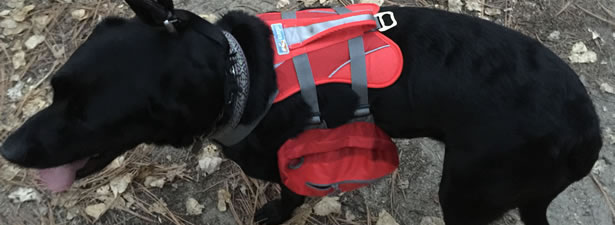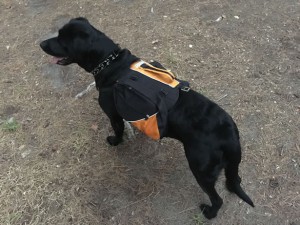What You Should Put in Your Dog’s Bug-Out Bag

People preparing for emergencies and disasters often forget to prepare for their pets, yet they’ll risk their lives trying finding them in the rubble. In this article we’re going to focus on dogs, and we’re going to talk not just about the things you should add to their bug out bags, but also about the unique needs they may have.
Which Backpack to Choose
Let’s talk start by talking about the backpack. Depending on which breed you have, yours may or may not be able to carry his own pouch, and the weight he can carry is limited. In fact, the weight is a big issue, just like it is for us, humans. Put too much and you’ll end up carrying it for him.
A good rule of thumb is to put 10%-15% of the dog’s weight on his back, but you can increase that in time. Just like you practice bugging out with your BOB when you’re hiking, your dog has to do the same. Dogs who train can carry up to a third of their weight, but you probably don’t want to go that far because you need your dog to be able to walk long distances.
 The weight of the dog isn’t the only factor, though. You also need to keep in mind his level of energy, health condition and the size of your dog’s chest before buying.
The weight of the dog isn’t the only factor, though. You also need to keep in mind his level of energy, health condition and the size of your dog’s chest before buying.
Which backpack to choose? Take a look at this review on the Kurgo Baxter Dog Backpack to start, and there are dozens more of them choose from on Amazon. Simply search for “dog backpacks” and check them out one by one. You not only need to pay attention to the size, but also the dog breed for which it was designed, and it is always a good idea to look at the comments from happy or not so happy customers. I suggest you get one that you can return if it doesn’t fit properly.
If your dog is young (by the way, you don’t want to have them carry weights if they’re younger than one year), you should get something that you can adjust as he grows.
I highly recommend you talk about this with your dog’s vet. You don’t have to tell him what the backpack is for, just that you’re looking to get your pet to be more fit.
What You Should Add to Your Dog’s BOB
Some of the essentials you should consider include:
Water
Water is heavy and it will amount for most of the weight. Of course, if you already have a filtration system inside your own backpack and if you know you’ll find plenty of water sources, you can skip it. The bigger the dog, the more water it can carry, but that’s not necessarily an advantage because he’ll also drink a lot more.
Food
Freeze-dried food is the lightest one you can get, but keep in mind it needs water in order to “cook”.
Boots
If you’re going to walk uneven terrain for hours on end, you can’t risk your dog stepping on a piece of glass or something else that would cause him to stop. The boots aren’t heavy at all, he just needs to get accustomed with them.
If you’ll be bugging out through the woods, you may want to consider rugged dog boots. Do whatever you can to make the bug out easier for your dog.
A First Aid Kit
Though I am not a doctor, I hear it’s good to keep your dog’s medical supplies separate from yours. Check with your vet to see which medical supplies are good to have in case of an emergency. Also, remember some of the problems your dog had to give you some more ideas of what to get.
A Food and Water Travel Bowl
You can use the bowl to keep other things if need be.
Hygiene Supplies
Hygiene is definitely going to be an issue post-collapse. If you’ve already added floss, toothpaste and nail clippers to your BOB, why not add some things in Lucky’s bag? Consider:
- dog nail clippers
- a dog brush (our previous dog, a German Shepherd, had so much hair it was unbelievable)
- flea spray
- dog’s toothpaste and a toothbrush
- cotton balls to clean your dog’s ears
A Leash
Is your dog scared of fireworks? If so, imagine what he’ll be like in a disaster situation. Whether you’ll bug out on foot or with your car, you or some other family member will have to keep a tight leash on your dog.
Tip: if you like multi-purpose items, you can forget the leash and store some Paracord instead. You can then use it to do various other things.
Chemlight Dog Collar
Very useful at night in order to keep an eye out for your dog. However, you should also consider the scenario of you not wanting to be found. In this case, you’ll either need a regular collar or you can use the Paracord we just talked about.
Speaking of which, if you want to do a fancy Paracord leash at home as a DIY project, this video will show you how:
A Muzzle
Whether your dog bites or not, you’ll never know how he’ll react when he’s scared and in a foreign environment.
Finding Your Dog If He Gets Lost
It’s funny but one of the best ways to making sure your dog doesn’t run away is to have a great leash and collar. Paracord isn’t ideal in this case because the dog may slip out of it. Up to you how you want to do this, it all depends on how much you want to spend. You can start with Paracord because it’s cheaper and, once you get a leash, you can put it in some other place, such as your car’s trunk. You never know when you might need it.
Another thing you can do is include personal information inside your BOB, info about both yourself and the dog… in case someone finds him. Of course, the safest way to know where your pet is at all times (provided you won’t get hit by an EMP) is to microchip him, but if you don’t want to do that, you can add a GPS tracker inside the pouch. It can cost anywhere from $20 to over $100.
What if you do lose your dog? Looking for it should be the first thing you do, but keep in mind you might be on the run from whatever natural or man-made disaster occurred. Caesar Milan, world-renowned dog expert has an article on his site on what to do.
Anything Else?
There’re a few more things your pet will need during a bug out that won’t fit into a pouch. I suggest you assign some space inside your car’s trunk. Check an older article of mine here on things to add in your car’s bug out bag. As for your dog, feel free to add things like:
- a dog crate
- a blanket
- toys
- and even an extra collar and a leash
Final Thoughts
As you can see, assembling a dog BOB is extremely easy. Most of the items are non-perishable, so you don’t have to worry about replacing them. Still, I recommend you use them regularly and even practice bug out scenarios with your dog, to get him accustomed with long walks, uneven terrain and Mother Nature.
Is there anything else you’ve done to prepare your dog for disaster scenarios? Let me know in a comment below.
![]()
About the Author
All content provided courtesy of Dan Sullivan of SurvivalSullivan.com.
DAN SULLIVAN doesn’t like prepping for Doomsday but urges everyone to worry about small-scale disasters and personal emergencies. Common sense is the rule of thumb for an author who decided he’s wants to offer some of the best survival and preparedness content for free.
--
